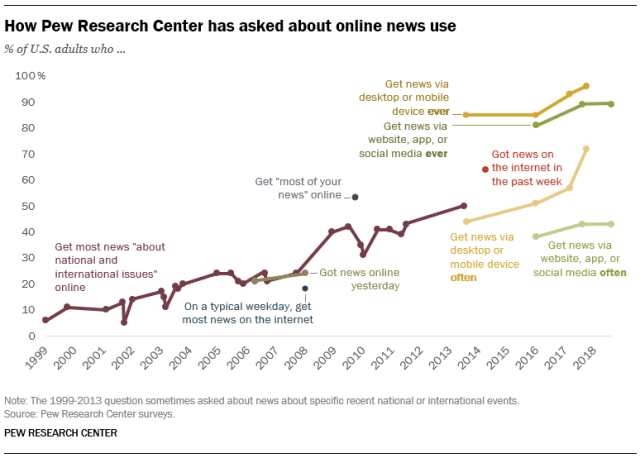
At Pew Research Center, we’ve been asking Americans about their online news habits since the mid-1990s. Since then, the ways people get news online have changed a lot — and so have the ways we ask about it.
In 1996, for example, we asked Americans whether they got news about that year’s presidential campaign from “computer on-line sources.” Today, with more Americans often getting online news through mobile devices than computers, that question wording sounds dated (and clunky). (For more on why question wording matters, watch our Methods 101 explainer).
This post explores two common challenges we’ve faced in measuring online news use over more than two decades: Identifying the many different ways that Americans get news online and understanding what survey respondents mean when they tell us about their online news habits.
Challenge #1: Identifying the variety of ways people get online news
The internet is a relatively new source of news for Americans, compared to, say, TV or radio. As a result, it can be hard to design surveys that get at the uniquely complicated nature of online news.
Many different organizations publish news online. Most established newspapers and TV networks have websites, for example, but there are also independent blogs that were founded online, social media accounts run by news organizations or members of the public, and search engines.
One of our earliest surveys about online news use focused on how traditional media organizations were dispersing their content online by asking about “the websites of the broadcast TV networks,” “the websites of national newspapers,” and “C-SPAN’s website.” As the number of online news sources grew, we needed to add additional questions that reflected sources not linked to a TV network or print newspaper, like when we asked about sources like “news blogs on the internet” in 2005.
In a survey after the 2006 midterm election, we tried to categorize all the forms of online news into four groups: newspaper websites, TV news websites, “Internet news sites such as Google news or Yahoo news,” and “other.” In that survey, the “other” category got as many responses as any of the other three categories, which is not something you usually want to see in an “other” response
The lesson was clear: There was a large section of online news sources that didn’t fit neatly into the buckets we had initially tried to use.

Challenge #2: Understanding how Americans think about their online news use
Online news is often associated with a legacy brand, like that of a print newspaper or television network. That can make it hard to understand what Americans are thinking about when they’re answering survey questions about their online news habits. For example, when a respondent is getting news from nytimes.com, does she primarily remember getting news online or getting news from The New York Times newspaper brand, whose flagship product is a print newspaper?
To get at these complicated answers, we sometimes ended up with complex, multi-step questions. Consider this example from a 2008 survey:

The phrase “ONLINE through the internet” makes clear how new this idea was at the time. While we wouldn’t use this phrasing today, one of our main concerns when asking about a new concept is making sure that respondents clearly understand what we’re asking. That’s why, in 2008, we walked respondents through multiple questions that set up the new concept — getting news online — only after asking about something more familiar, like getting news from a print newspaper.
Looking through past surveys, there are other questions that now seem too blunt, or unnecessarily spelled out. In 2012, for instance, we defined a mobile app very thoroughly:

Today, we would no longer put the word “app” in quotation marks. But defining a mobile device for people can still be tricky. When people are getting news from an app without opening up a browser, for instance, do they still consider that getting news “online?” When they get news via email, or a Twitter app, do they think of that as “online” in the same way they might think about a newspaper’s website?
Conclusion
Over more than 20 years of fielding these surveys, there have been big changes in the way that Americans get news online. For example, we tracked the increase in internet news use from 1999 to 2013, and reported when the internet overtook newspapers as a news source. Now, the share of U.S. adults who get news online is approaching the share who get it from TV. And social media sites have now surpassed print newspapers as a news source for Americans.

We currently have two sets of questions that get at people’s overall online news use. First, we combine the news people get on websites, apps, or social media sites — focusing on the platforms where people are getting their news. Second, we ask about the physical devices where people get news online — on desktops, laptops and mobile devices. These are the questions that we think best represent how people are getting news online at this point in time. But in the future, these questions may need to continue to change, to best represent people’s evolving online news habits and perceptions.






